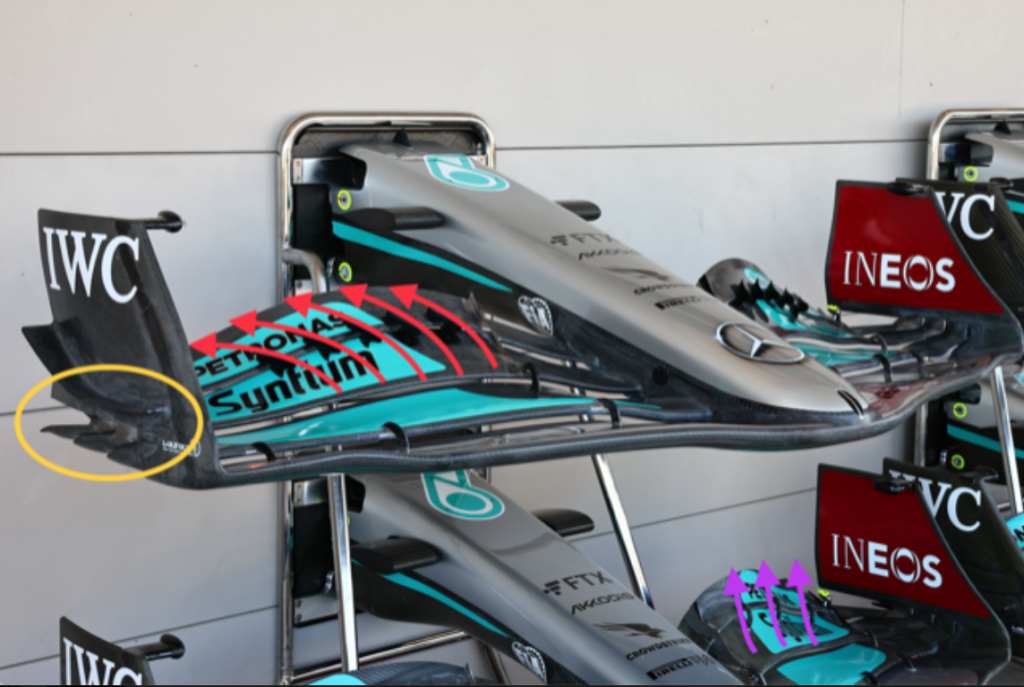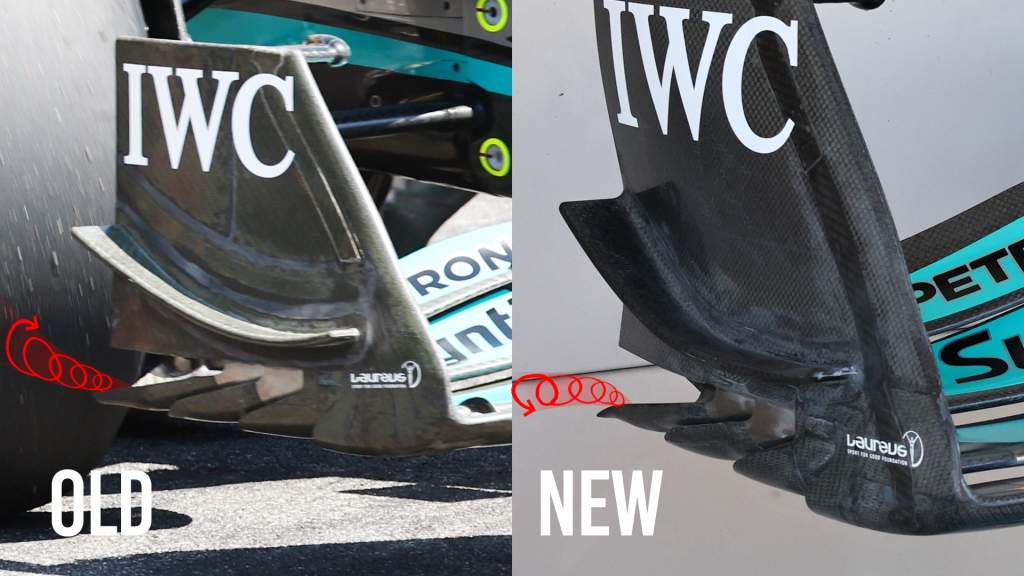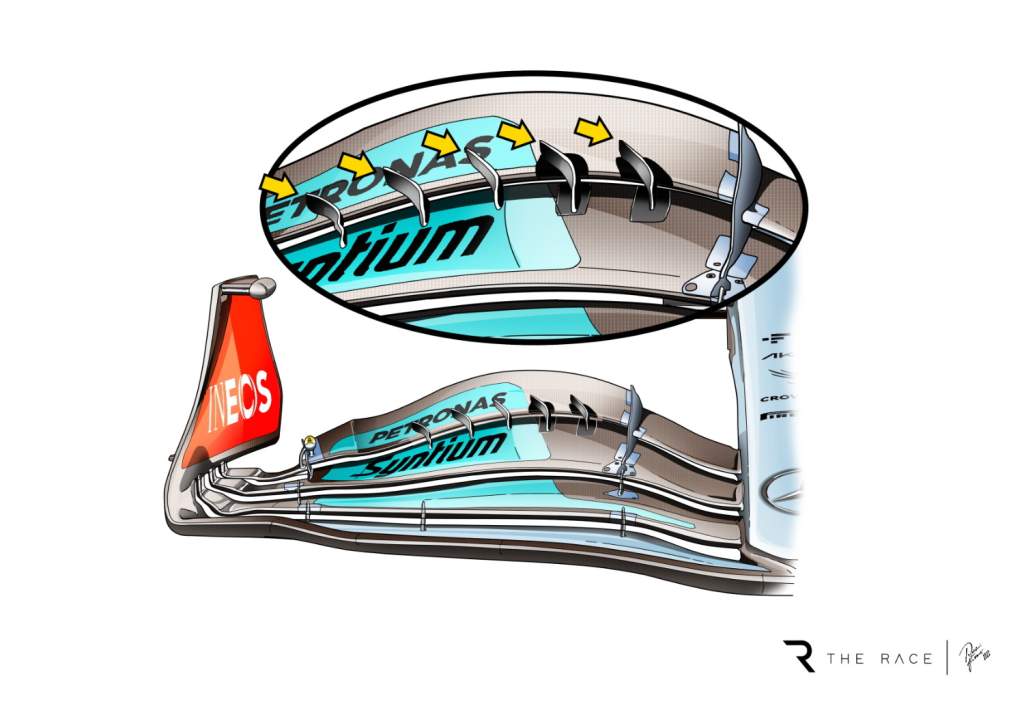Up Next

The Mercedes Formula 1 team has a new front wing at the United States Grand Prix that is conceived to encourage aerodynamic outwash.
The wing has not run today as the team only has one example of it available and its characteristics aren’t suited to the track. However, the intention is for it to be trialled in Mexico next weekend.
The big question is: when is a slotgap separator a slotgap separator and when is it being exploited into the grey area of what might just be acceptable?
Mercedes introduced a highly detailed front wing endplate (yellow ellipse) earlier in the season.

It was accepted by the FIA even though there is a written regulation to try to restrict any new ideas for generating what used to be called outwash.
The objective of the new rules was to minimise this, as it was part of the airflow structure that was believed to be generating the problematic turbulence that was compromising the racing.
On the wing Mercedes has brought to Austin, the detail of the lower trailing edge of the endplates has been altered. These small changes will alter the flow structure around the front tyre. The vortices coming off the old one will be a lot higher than the new one.

The new airflow should also be rotating in the opposite direction, which again will help to keep it low and improve how it connects up to the tyre squirt as the tyre rotates onto the track surface and forces this flow around the outside of the front tyre contact patch.
Again, all this creates more outwash. Now it’s down to the FIA and how it views increasing just what these 2022 aerodynamic regulations were meant to eliminate, or at least reduce.

Mercedes has also taken this a step further by increasing the power of the flow separators between the third and fourth (rear) front wing flap.
As can be seen on the lower wing assembly (magenta arrows) these used to consist of just three fairly simple plate-style separators.
Now on the new version Mercedes has five (red arrows) all designed with more of an aerodynamic profile to help turn this flow outwards into the flow generated by that new endplate design.

If this flow can be connected to the airflow that is displaced when the front tyre rotates onto the track surface it will again generate more outwash.
This means that more flow will be pulled in under the central part of the nose and chassis to help feed the leading edge of the underfloor.
It is possible Mercedes will also use these new slotgap separators to reduce the deflection of its front wing flap assembly. Everyone allows deflection here to some degree, but I think Mercedes overdoes it just that bit too much – making a mockery of the regulation regarding flexible bodywork.
Regulations are regulations, but although it matters what is written, it is the implementation of those regulations that is important.
Without seeing the new assembly up close to inspect it, I have to assume it complies fully with both the written rules and the intention of the rules. The Race understands suggestions it has been deemed illegal for 2022 by the FIA are wide of the mark.
For reference, below are the regulations that cover this area. They are not easy to understand and I am sure there are a few more littered around that might also touch on this area, but this just gives you a reference to how complicated they are:
3.9.8 Front Wing Auxiliary Components
The following components will be permitted in addition to the Front Wing Assembly for primarily mechanical, structural or measurement reasons:
a. Up to three brackets which define the pivot axis of the FW Flap, and allow the necessary movement. These brackets must:
i. be in their entirety within 40mm of the FW Flap, per side of the car, over the whole range of adjustment.
ii. be no more than 5mm thick. A fillet radius no greater than 2mm will be permitted where these brackets join the two profiles.
iii. have no dimension that exceeds 80mm.
b. Up to eight slot gap separator brackets, per side of the car, which connect consecutive FW Profiles. These brackets must:
i. be in their entirety within 40mm of both of the two profiles they support in relation to each other.
ii. be no more than 6mm thick. A fillet radius no greater than 2mm will be permitted where these brackets join the two profiles.
iii. have no dimension that exceeds 70mm.
c. A mechanism with or without a fairing to contain it for the angle adjustment of part of the FW Flap, as defined in Article 3.9.7. This mechanism and fairing must fit within a cuboid of which is 25mm wide, 60mm long and 60mm high. This cuboid may have a free orientation in space, but must intersect both the stationary and the adjustable part of the profiles for the entire range of adjustment.
Full list of US GP upgrades
Mark Hughes
Only three teams have declared new parts for Austin.
Mercedes
Mercedes’ upgrade is quite extensive and includes changes to the front wing, floor edges, floor fences and rear wing endplate.
The front wing flaps have been reduced in camber and slotgap separators have been added. This is in a bid to better control the airflow around the tyre and therefore further down the car.
The floor edge winglet has been increased in size, adding load to that specific forward part of the floor. The geometry of the floor fences has been tweaked to give an improvement in diffuser performance.
The rear wing endplate changes are claimed to give greater load to the upper wing.
Alpine
A winglet has been added beneath the floor edge towards the rear, improving flow around the diffuser.
Alfa Romeo
There’s a new leading edge for the floor with additional cut-outs. The floor has been re-optimised around the new front wing introduced at Suzuka.




